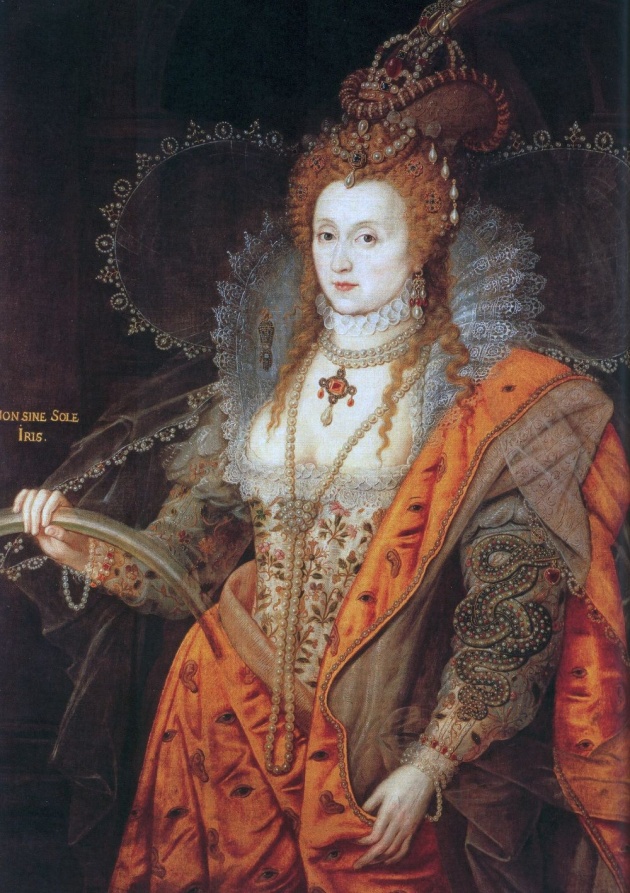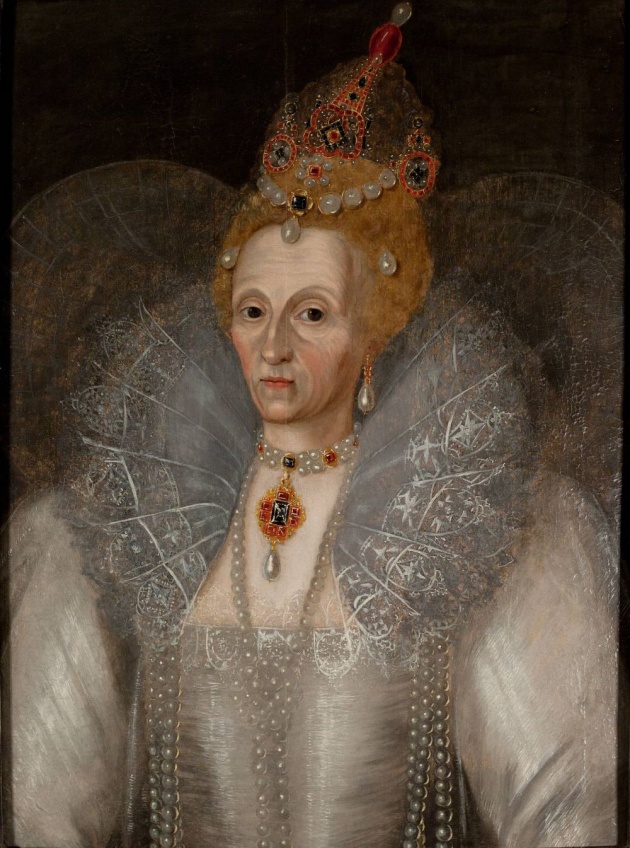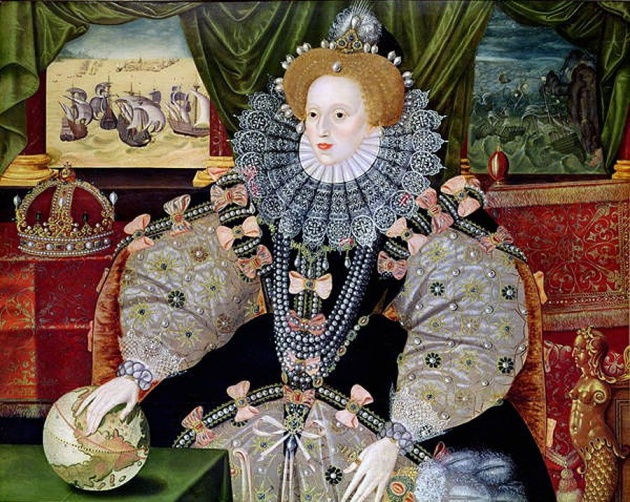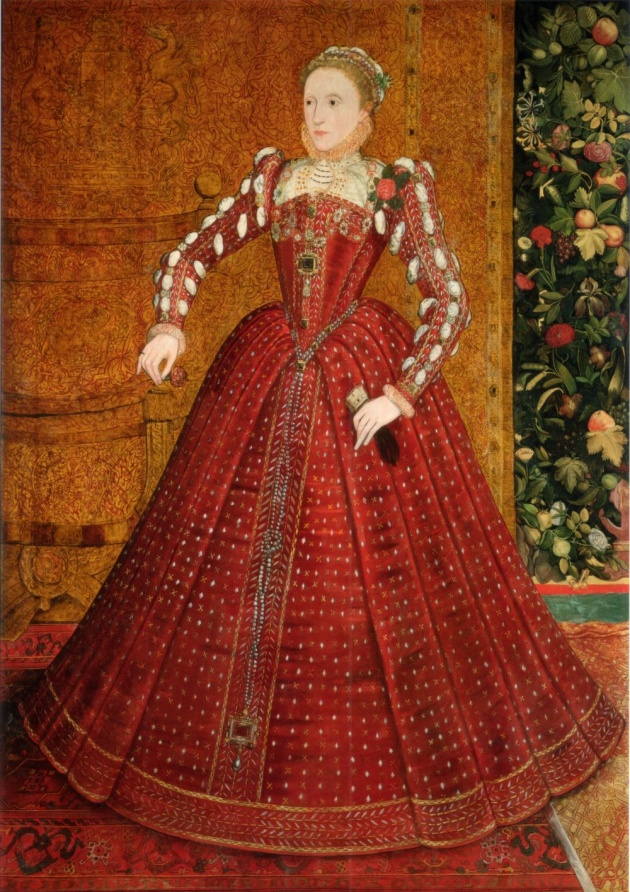
PEELING BACK THE MASK:
But beneath the image of a strong, confident and youthful monarch lay a very different woman – one that only those closest to her would ever see, and centering around the relative privacy of the royal bedchamber. Here, in the heart of Elizabeth’s empire, the physical reality of the ageing Queen was disguised by a multitude of cosmetics, administered by a handful of privileged women whose task it was to guard the truth of the Queen’s body . In 1562, when she was just 29, Elizabeth caught smallpox and nearly died. The severity of her illness, and the stark reality that the she could die without an heir, shook the country and for the first time Elizabeth’s mortality hit home. For Elizabeth, though, the illness had a visible long-lasting effect in the form of facial scars. Layers of white make-up – a concoction of pungent white lead and vinegar – were applied to her face in a bid to conceal the imperfections.
But the caustic cosmetic did more harm than good. The prolonged use of lead eventually ate into the Queen’s skin, causing it to grey and wrinkle, and thus more of the paste was required to achieve the desired effect. In line with Elizabethan fashion, bright patches of rouge were applied to the Queen’s cheeks using crushed cochineal beetles. But as she aged, Elizabeth stepped up her quest for everlasting youth, experimenting with cutting-edge cosmetics. An intense for use on lips and cheeks was create with vermilion, a garish pigment also known as cinnabar – or today as mercuric sulphide. This toxic substance was smeared daily on the Queen’s mouth, and would have been ingested every time she licked her lips. Eventually, it is highly likely Elizabeth would have experienced the lack of co-ordination, memory loss, sensory impairment, slurred speech and depression – all symptoms linked to mercury poisoning.
KEEPING UP APPEARANCES:
Over the decades of Elizabeth’s reign, she privately changed from a young, lithe, pretty royal with little need for make-up, to a wrinkled, black-toothed woman who spent hours every day preparing for public viewing.
Her love of sweet foods meant that she frequently suffered from toothache, and many of her teeth fell out. Once, just before her 45th birthday, the pain in her teeth and gums proved unbearable and she consented to an extraction. Afraid of pain and unwilling – perhaps for vanity’s sake – to lose a tooth, Elizabeth finally allowed doctors to perform the procedure only after John Aylmer, Bishop of London, had one of his own extracted in front of her. Reassured, Elizabeth finally agreed to the action.
What’s more, her red-gold hair, once Elizabeth’s crowning glory and tangible evidence of her Tudor heritage, began to thin soon after she took to the throne and she had to wear wigs to disguise her hair loss. But while Elizabeth could disguise physical imperfections such as her lack of hair and scarred face, some health problems were harder to hide. The question of the Queen’s ability to bear children and the irregular menstruation that she had endured since childhood were on the rumour mill throughout Europe. So anxious was Elizabeth to demonstrate her health and vigour to the world that she often felt compelled to perform feats of exercise before her court. She would dance energetically with foreign ambassadors, lead hunts and spurn medicine in public. But even in the privacy of her bedchamber, Elizabeth was still under constant scrutiny. Her ladies were often bribed by foreign ambassadors for intimate details of the ruler’s private life – from her menstrual cycle to her virginity . As she grew older, less youthful and more suspicious, Elizabeth took great pains to ensure only those closest to her saw her in her natural state – without wig, make-up or robes. But in September 1599, Elizabeth’s ‘mask of youth’ was well and truly torn off when royal ff favourite Robert Devereux, Earl of Essex, burst into her bedchamber unannounced. Devereux, it was reported, “found the Queen newly up” with wisps of grey thinning hair “hanging about her ears”, no make-up and dressed in a simple robe. It was a sight that none of Elizabeth’s court should have been privy to, and the monarch was mortified.
A QUEEN AT ODDS:
Elizabeth’s skill as an orator and her devotion to England is well documented, but her public displays of dignified queenly duty were often at odds with her behaviour behind closed doors. For a woman who publicly declared that she had “the heart and stomach of a king”, Elizabeth’s subjects would have been shocked to learn that their Queen was scared of the dark. So too, would they be surprised by the notion of their monarch suffering from regular nightmares – especially after the execution of Mary , Queen of Scots – after which she would need comforting. In the dark of night, Elizabeth would lie awake, fretting about decisions she had made, or was under pressure to make, and she suffered from insomnia for most of her life.
Towards the end of her reign, Elizabeth was also prone to bouts of depression, particularly as she began outliving those she loved most. In 1588, as she was being publicly celebrated in the wake of victory over the Spanish Armada, Elizabeth shut herself away at St James’s Palace, mourning the loss of her close friend Robert Dudley who had died unexpectedly, just weeks after the battle. The execution of Devereux, the man who had so ignominiously burst into the Queen’s bedchamber, was another blow to the her fragile state of mind. She became more reclusive, and began to keep to the relative safety of her privy chamber, away from the watchful eyes of court. As it became harder to keep the aging process at bay, less-than-complimentary comments about Elizabeth’s looks began to be reported by foreign ambassadors. In 1597, the 65-year-old Queen was described in a letter by the French ambassador: “As for her face, it is and appears to be very aged. It is long and thin, and her teeth are very yellow and unequal... Many of them are missing so that one cannot understand her easily when she speaks quickly.” For a queen who loved to be adored, growing old so publicly must have been agonising. Yet to her subjects, she remained Gloriana, the Virgin Queen, who had eschewed marriage to become mother of the nation. On Elizabeth’s death in 1603, thousands turned out for her funeral, lamenting the passing of their beloved monarch.
THE END...
ELIZABETH (The Real Face) (P2)
Posted on at



